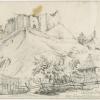‘Old Castle of Doboj’
Commentary
Page featuring an engraving (made after a drawing by Arthur Evans), captioned ‘Old Castle of Doboj’, published in Arthur J. Evans, Through Bosnia and the Herzegóvina on Foot during the Insurrection, August and September 1875 (London, 1876), p.105.
Artist: Unidentified engraver, after an original drawing [1941.8.182] by Arthur John Evans
Date of publication: 1876
Continent: Europe
Geographical area: Southern Europe
Country: Bosnia and Herzegovina
Region/Place: Doboj
Cultural group: European Bosnian
Format: Woodcut engraving
Page size: 234 x 141 mm
Acquisition: Henry Balfour. Bequeathed February 1939
***
Research notes: It has been identified by Philip Grover that this woodcut engraving by an unnamed artist was based on an original drawing [1941.8.182] by Arthur John Evans, being a view of the fortress of Doboj. It was published in Evans’ account of his journey, Through Bosnia and the Herzegóvina on Foot during the Insurrection, August and September 1875(London, 1876), p.105, printed with the caption ‘Old Castle of Doboj’. Evans recorded in the volume: ‘About half an hour after, resuming our trudge, on passing a turn in the road, the old castle of Doboj rose before us, finely seated on a canonical hill. [...] We now directed our footsteps to the old castle that crowns the summit of the hill. The “Starigrad,” as it is called here, is one of the most interesting historic relics in the whole of Bosnia. A glance from its mouldering walls makes one realise the importance of its situation. The peak on which the castle of Doboj stands juts out abruptly into the valley of the Bosna just at the point where in one direction the Sprecca opens out an avenue towards the Drina and Serbian frontier, and in the other the pass of Dervent conducts the road to Croatia. The castle, therefore, was the key to the whole valley of the Bosna against a foe coming from the Hungarian plains, and commanded the highway through the province of Ussora to the very heart of the Bosnian kingdom. The maize-covered river-flat that spreads below it seems one of those spots destined by nature to be the battle-field of nations; and the very name of Doboj or Dvoboi, as it was formerly written, means in Bosniac ‘the two fights’./ As Prince of Ussora, this castle belonged to Tvartko I., who first erected Bosnia into a kingdom. He entrusted the stronghold to the safe keeping of the Croatian Ban, John Horvath, with whom he was bound by common jealousy of the Hungarian suzerain’: Through Bosnia and the Herzegóvina on Foot, pp.103, 104–105.

